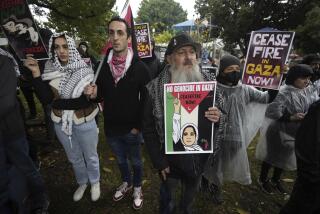Book Review : Class Division: Matter of Life and Death
- Share via
The Jews of Paris and the Final Solution by Jacques Adler (Oxford, $29.95, 320 pages)
To the memory of my father, Szymon Jacob Adlerstejn, killed at Birkenau.
To the French who saved my mother and my sister.
To my comrades of the company Rayman, Battalion 51/22, le Regiment de Paris.
The brief piercing dedication at the beginning of this precise and scholarly book not only presents the author’s credentials and his compelling reasons for writing it, but also explains his often ambivalent point of view.
Readers who may not remember or realize that the Company Rayman was part of the Jewish Communist underground are reminded of that fact on the first page of the preface, where Jacques Adler expands on the origins of his project.
In the summer of 1975, 30 years after the end of World War II, he was invited to a reunion of former members of his battalion. There, surrounded by his comrades and deeply affected by their shared recollections, he found himself tormented by the still unanswered questions of why and how some people and not others survived the Holocaust; if the more fortunate had in fact done everything humanly possible to aid the helpless, and perhaps most fundamental of all: “Are people powerless when confronted by a state determined to destroy them?”
In seeking answers to these haunting riddles, Adler emphasizes the deep schism that separated assimilated French Jewry from more recent immigrants from Eastern Europe, a division he sees as economic and cultural; a class distinction that caused a privileged haute bourgeoisie to dissociate itself from a proletariat.
Major Impediment
Until 1943, when increasingly Draconian measures forced all French Jewish organizations to acknowledge the Nazi peril and unite in a common cause, the author finds this attitude a major impediment to effective resistance.
While Adler believes official and elitist groups dissipated their energies in futile attempts at conciliation, he maintains that the Jewish Communist underground was “The first and only organization in the Paris Jewish community to take up arms . . . for which they were perceived by other Jews as provocateurs who were putting the community at risk,” thereby exacerbating the existing schisms and wasting precious time.
The book deals explicitly and at length with the various survival strategies developed by the different Jewish associations, analyzing and evaluating them in terms of their effectiveness. Where credit is due, Adler ungrudgingly and generously grants it, putting his political bias aside. On the surface, the record may seem heartening because statistically, only a quarter of the Jewish population was lost.
Adler’s explorations, however, dim the luster of these figures. He finds that the casualties were overwhelmingly drawn from the newer immigrant groups, always poorer and less integrated into French life than the native born; pathetically vulnerable to the brutal edicts and fatal conscriptions.
His most corrosive criticism is directed at the Central Consistory, the official representative of French Jewry, which initially tried to deal with the Nazi threat by closing French borders to refugees; the leaders deluding themselves that French citizens of long standing would be exempt from prosecution.
As Adler explains, the vast majority of French-born Jews had come to regard their religion as purely a matter of observance, entirely severing it from any national or cultural undertones.
Staunch Zionists
While the immigrant groups were often at loggerheads over political issues, they were generally in accord on a concept of nationhood. Most, having recently escaped countries in which they lived in perpetual economic and social limbo, were staunch Zionists. These basic differences in attitude inevitably led to conflict when the disparate groups were obliged by dire circumstances to act in uneasy conjunction.
Eventually, the abyss separating the French from the foreign-born was closed, temporarily bridged by the indiscriminate application of the “Final Solution.”
Meticulous and extensive documentation supports Adler’s conviction that the immigrants’ organizations provided the only effective defense, finally forcing the Central Consistory and other conservative societies into vigorous activism. The book is logically organized and closely reasoned, a timely and distinguished addition to the immense body of Holocaust literature.
Presented openly and immediately, the author’s strongly held political views in no way compromise or detract from the usefulness of this highly specialized work.
More to Read
Sign up for our Book Club newsletter
Get the latest news, events and more from the Los Angeles Times Book Club, and help us get L.A. reading and talking.
You may occasionally receive promotional content from the Los Angeles Times.







